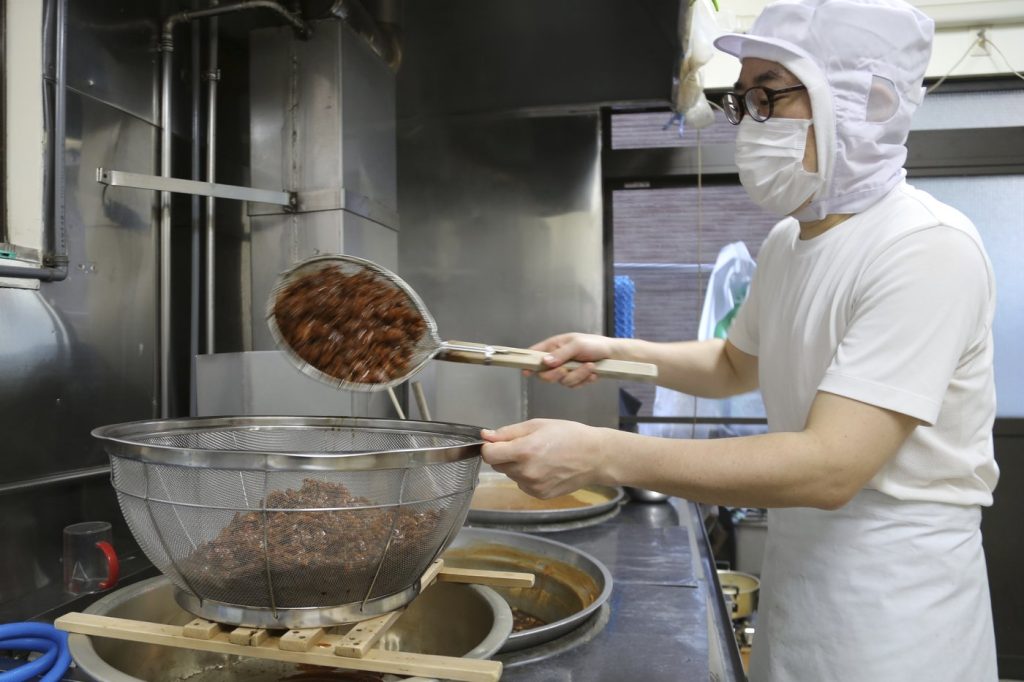TOKYO (AP) — The daily routine of Yoshihiro Kobayashi and his father, Nobuo Kobayashi, begins each morning at 5 a.m. The father-son duo operates a traditional tsukudani shop, where they diligently engage in the time-honored craft of preparing Japanese food tsukudani, a preserved delicacy that has been part of the nation’s culinary heritage for centuries. Their interactions remain minimal, communicating through actions rather than words as they methodically complete their tasks, all while sweat beads form on their foreheads under the heat of their kitchen.
Tsukudani, a dish that encapsulates Japan's gastronomic tradition, consists of various ingredients — such as tuna, tiny shrimp, and seaweed — simmered in a sweet syrup made from soy sauce, sake, and sugar. This method of preservation dates back over 200 years to the Edo Era, at a time when refrigeration did not exist. Today, they focus on clam tsukudani, cooking two pots from 6 a.m. to 7 a.m. and two more from 7 a.m. to 8 a.m. As orders begin to flow in from local restaurants and stores, they plan to prepare additional items throughout the afternoon, remaining careful not to disturb the delicate ingredients too much during the cooking process.
Yoshihiro, who initially sought a different career path in the fashion industry and department stores, eventually returned to the family business, recognizing the rich heritage and skills passed down from his father. Despite acknowledging Nobuo's strict and traditional approach, Yoshihiro expresses a profound respect and love for the art they practice together. Nobuo, while serious, exhibits a playful side, especially when he jokingly comments on a reporter’s camera, showcasing a lighter dynamic between them.
The family shop, Tsukushin, is located in the quaint Tsukuda neighborhood near the Sumida River in downtown Tokyo. This area is significant in the history of tsukudani, the dish being named for its place of origin – "cooked in Tsukuda." Their establishment proudly displays signs proclaiming its status as the original tsukudani maker. In stark contrast to the mass production of tsukudani in modern factories, the Kobayashi shop utilizes traditional earthen vessels, known as "kamados," for cooking. Although these vessels originally relied on wood and charcoal, they now operate with gas. The meticulous simmering process takes about an hour and allows for limited quantities, reinforcing their commitment to artisan craftsmanship.
Yoshihiro compares tsukudani to jam in the West, emphasizing its traditional role in Japanese cuisine. Typically enjoyed with a bowl of hot rice, tsukudani can be paired with miso soup or soy-bean paste soup. It is also a popular snack alongside sake and can serve as a filling for rice balls or a side dish in bento lunch boxes. While Yoshihiro insists on the traditional methods of consumption, he also notes the challenge of educating both international visitors and younger Japanese about tsukudani's merits, as many may not even be familiar with the dish.
Noriko Kobayashi, a non-related vendor in Tokyo selling African and Scandinavian crafts, shares her own experiences with tsukudani, revealing her unassuming appreciation for it. She enjoys seaweed tsukudani with cheese and sake, while reflecting on its health benefits, recognizing it as a wholesome food option she has cherished since childhood.
This portrayal of the Kobayashi family and their commitment to preserving tradition through the art of tsukudani not only highlights the culinary importance of the dish, but also sheds light on Japan’s broader cultural ethos. In a society marked by high-tech advancements and global corporate influences, small businesses like Tsukushin stand as bastions of enduring Japanese customs, reminding the world of the richness rooted in their culinary heritage.










